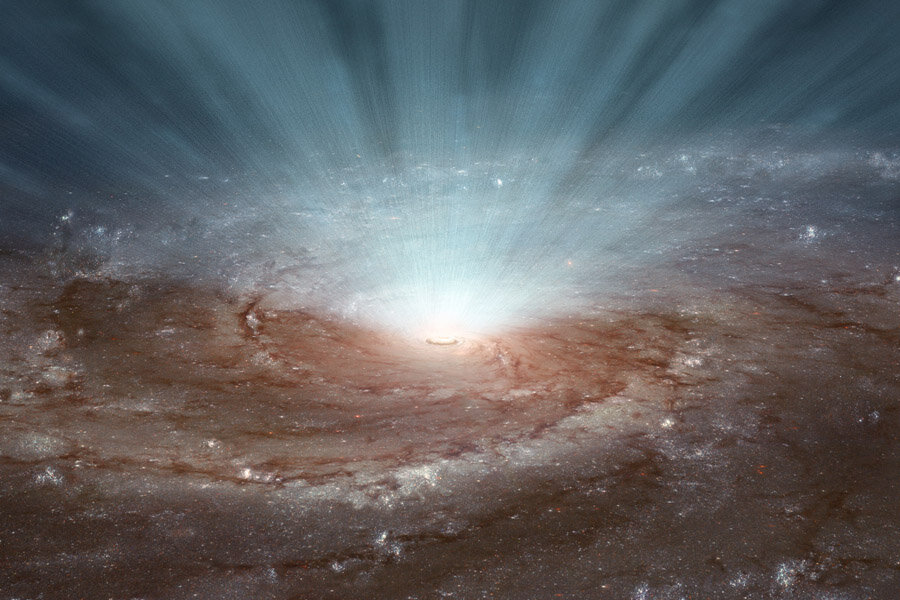How a black hole's cosmic burp could change the galaxy
Loading...
A ravenous, giant black hole has belched up a bubble of cosmic wind so powerful that it could change the fate of an entire galaxy, according to new observations.
Researchers using two X-ray telescopes have identified a cosmic wind blowing outward from the supermassive black hole at the center of galaxy PDS 456. Astronomers have seen these winds before, but the authors of the new research say this is the first observation of a wind moving away from the center in every direction, creating a spherical shape.
The wind could have big implications for the future of the galaxy: It will cut down on the black hole's food supply, and slow star formation in the rest of the galaxy, the researchers said. And it's possible that strong cosmic winds are a common part of galaxy evolution — they could be responsible for turning galaxies from bright, active youngsters to quiet middle-agers. [The Strangest Black Holes in the Universe]
Big eater
The supermassive black hole at the center of PDS 456 is currently gobbling up a substantial amount of food: A smorgasbord of gas and dust surrounds the black hole and is falling into the gravitational sinkhole.
As matter falls, it radiates light. The black hole at the center of PDS 456 is devouring so much matter, that the resulting radiation outshines every star in the galaxy. These kinds of bright young galaxies are known as quasars: a galaxy with an incredibly bright center, powered by a supermassive black hole with a big appetite.
New observations of PDS 456 have revealed a bubble of gas moving outward, away from the black hole. Using NASA's Nuclear Spectroscopic Telescope Array (NuSTAR) and ESA’s (European Space Agency) XMM-Newton, the authors of the new research imaged the galaxy on five separate occasions in 2013 and 2014. The researchers say they can show that the photons of light emitted by the in-falling matter are pushing on nearby gas, creating the wind.
Scientists have studied these cosmic winds before, but the authors of the new research say their work goes a step further.
"It tells us that the shape of the wind is not just a narrow beam pointed in our direction. It is really a wind that is flowing in every direction away from the black hole," said Emanuele Nardini, a postdoctoral researcher at Keele University in Staffordshire, England. "With a spherical wind, the amount of mass it carries out is much larger than just a narrow beam."
According to a statement from NASA, galaxy PDS 456 "sustains winds that carry more energy every second than is emitted by more than a trillion suns." Such powerful winds could change the entire landscape of PDS 456, the researchers say. First, the wind will blow through the disk of matter surrounding the black hole — this disk currently serves as the black hole's food supply. The cosmic wind created by the black hole's appetite could significantly reduce or destroy the disk. In other words, the black hole cannot have its cake and eat it, too. [Images: Black Holes of the Universe]
Bright young things
With no matter left to fall into the black hole, the radiation would cease as well. The brilliant center of the quasar will dim. By diminishing the black hole's food supply, they may turn quasars and other "active galaxies" like PDS 456 into quiescent galaxies like the Milky Way. Theorists have proposed that cosmic winds could explain why there are more young active galaxies than old active galaxies.
"We know that in almost every galaxy, a supermassive black hole resides in the center," said Nardini. "But, most of the galaxies we see today are quiescent, they are not active in any way. The fact that galaxies today are quiescent — we have to find an explanation for that in something that happened a long time ago."
In addition to quenching the radiation from an active black hole, these cosmic winds may slow down star formation in galaxies. The cosmic wind could blow through regions thick with gas and dust, where young stars form, and thin out the fertile stellar soil.
"If you have a black hole with this kind of wind, in millions of years [the winds] will be able to quench star formation and create a galaxy like our own," Nardini said. Stars will still form in the Milky Way, but not at the high rate of many young galaxies.
It's possible that these cosmic winds are a central reason why most galaxies go from being brightly burning active youngsters to quiet middle-agers.
Follow Calla Cofield @callacofield. Follow us @Spacedotcom, Facebook and Google+. Original article on Space.com.
- No Escape: Dive Into a Black Hole (Infographic)
- Black Holes: Facts, Theory & Definition
- Top 10 Strangest Things in Space
Copyright 2015 SPACE.com, a Purch company. All rights reserved. This material may not be published, broadcast, rewritten or redistributed.







